Recommendations: Organizations, Teams, Methods and Management
Organizations, Teams, Methods and Management
 Kanban is an informative book, but one that could be more tightly written. I learned a lot from reading this book, but the presentation sometimes made it harder than it could have. It clearly explains the basics of Kanban and how to apply it to software developments well as both how a Kanban approach differs, and can be used to support, Agile methods such as Scrum. The anecdotes and examples in the book help you to understand how to apply Kanban in real projects in organizations of varying sizes, and the takeaways section at the end of each chapter has a concise summary of what the chapter discussed. On the other hand, some of the anecdotes were a bit long and rambling, and contrasted sharply with other very well focused sections. This would have been a much better book had the author either kept the anecdotes briefer, or started the longer anecdotes with some more guidance about what we might expect to learn from the subsequent story.
If you are willing to skim a bit (and occasionally backtrack) you can get a lot of value from this book if you want to learn about Kanban. This is a good book. It could have been a much better one.
Kanban is an informative book, but one that could be more tightly written. I learned a lot from reading this book, but the presentation sometimes made it harder than it could have. It clearly explains the basics of Kanban and how to apply it to software developments well as both how a Kanban approach differs, and can be used to support, Agile methods such as Scrum. The anecdotes and examples in the book help you to understand how to apply Kanban in real projects in organizations of varying sizes, and the takeaways section at the end of each chapter has a concise summary of what the chapter discussed. On the other hand, some of the anecdotes were a bit long and rambling, and contrasted sharply with other very well focused sections. This would have been a much better book had the author either kept the anecdotes briefer, or started the longer anecdotes with some more guidance about what we might expect to learn from the subsequent story.
If you are willing to skim a bit (and occasionally backtrack) you can get a lot of value from this book if you want to learn about Kanban. This is a good book. It could have been a much better one.
Related books
 If you are familiar with Lean or Agile software development you have probably heard many of the concepts in this book. Eric Ries explains how to use the techniques of lean production including testing, feedback, and other key agile development enablers at the business and organizational level to innovate. The book emphasizes that the key to getting better at what you do is to have goals, test, measure, and use techniques like "5 Why's" to understand problems, This book will help you to understand understand that being lean is an organization-wide process. An enjoyable read, filled with stories from both Ries' consulting and startup experience and filled with references to sources for more information, this book can help you to understand how to innovate, whether you are working on a project of starting a company. Business people will learn more about lean engineering, engineers will learn how lean applies to the business. (These comments are based on an advanced review copy of the book)
If you are familiar with Lean or Agile software development you have probably heard many of the concepts in this book. Eric Ries explains how to use the techniques of lean production including testing, feedback, and other key agile development enablers at the business and organizational level to innovate. The book emphasizes that the key to getting better at what you do is to have goals, test, measure, and use techniques like "5 Why's" to understand problems, This book will help you to understand understand that being lean is an organization-wide process. An enjoyable read, filled with stories from both Ries' consulting and startup experience and filled with references to sources for more information, this book can help you to understand how to innovate, whether you are working on a project of starting a company. Business people will learn more about lean engineering, engineers will learn how lean applies to the business. (These comments are based on an advanced review copy of the book)
Related books
 When I reviewed an early draft of this book I was pleased to see a book on SCM that wasn't just about tools and processes (though it covers those things) but also about people. SCM is about enabling people to work together effectively, and tools and processes are essential, but you need to use them with an understanding of how people work. This book covers not just version control but the range of CM activities from build to deployment, even covering hardware CM issues. While anyone who works with software may benefit from this book, those who manage teams and project or are looking to improve their SCM processes will find the approach especially useful.
When I reviewed an early draft of this book I was pleased to see a book on SCM that wasn't just about tools and processes (though it covers those things) but also about people. SCM is about enabling people to work together effectively, and tools and processes are essential, but you need to use them with an understanding of how people work. This book covers not just version control but the range of CM activities from build to deployment, even covering hardware CM issues. While anyone who works with software may benefit from this book, those who manage teams and project or are looking to improve their SCM processes will find the approach especially useful.
Related books
 This is one of those books that describes something extremely obvious and intuitive that at the same time goes against what you were taught was "common sense." This would be a good book just for the survey of the (long) history of the study of the theory of motivation. It also concludes with a number of things you can do to create an environment that encourages mastery (as opposed to simply meeting goals) in your work and school. As an agile software developer I had a few aha! moments when you understand how agile practices really encourage flow and create environments where teams and individuals can be highly productive. As a parent, this book re-enforced that the way children approach learning and problems is something to be viewed with awe. If you're a manager, this book will encourage you to think about how teams work and how some common practices are counter-productive. It's a quick read that will get you thinking and learning.
This is one of those books that describes something extremely obvious and intuitive that at the same time goes against what you were taught was "common sense." This would be a good book just for the survey of the (long) history of the study of the theory of motivation. It also concludes with a number of things you can do to create an environment that encourages mastery (as opposed to simply meeting goals) in your work and school. As an agile software developer I had a few aha! moments when you understand how agile practices really encourage flow and create environments where teams and individuals can be highly productive. As a parent, this book re-enforced that the way children approach learning and problems is something to be viewed with awe. If you're a manager, this book will encourage you to think about how teams work and how some common practices are counter-productive. It's a quick read that will get you thinking and learning. Related books
 If you thought that performance review processes and incentive systems are often flawed, but wanted to understand why, Austin's book will give you a model to understand dysfunctional measurement processes, and a path to understanding how to avoid the dysfunctions and really help organizations and teams perform in a way that improves quality and gives customers what they want. Though the core of this book is an economic model, the book is quite readable and enjoyable. While this book was written before many people had heard of agile or Scrum, the model in the book also helps you understand why the approach of self-organizing teams that agile methods advocate can be very effective. Many of the conclusions in this book seem like common sense, but like many things, common sense is not synonymous with common practice, especially among people want to measure things. If you manage people consider reading this book to get a deeper understanding about incentive systems in addition to Behind Closed Doors: Secrets of Great Management which will help you to learn how to effectively manage people day-to-day to improve performance
If you thought that performance review processes and incentive systems are often flawed, but wanted to understand why, Austin's book will give you a model to understand dysfunctional measurement processes, and a path to understanding how to avoid the dysfunctions and really help organizations and teams perform in a way that improves quality and gives customers what they want. Though the core of this book is an economic model, the book is quite readable and enjoyable. While this book was written before many people had heard of agile or Scrum, the model in the book also helps you understand why the approach of self-organizing teams that agile methods advocate can be very effective. Many of the conclusions in this book seem like common sense, but like many things, common sense is not synonymous with common practice, especially among people want to measure things. If you manage people consider reading this book to get a deeper understanding about incentive systems in addition to Behind Closed Doors: Secrets of Great Management which will help you to learn how to effectively manage people day-to-day to improve performance
Related books
 Portfolio management sounds neither compelling nor agile, yet in this book Johanna Rothman explains not only the importance of portfolio management, but also how portfolio management and agile development approaches enable each other. By a combination of guidelines, stories, and references Rothman teaches you how to define a mission, prioritize your product development plan, and enable your organization to get more done while reducing technical debt, and enhancing flexibility. This is an approachable and engaging book that will appeal to project managers, technical leads, and anyone interested in understanding how to develop and execute a consistent project strategy.
Portfolio management sounds neither compelling nor agile, yet in this book Johanna Rothman explains not only the importance of portfolio management, but also how portfolio management and agile development approaches enable each other. By a combination of guidelines, stories, and references Rothman teaches you how to define a mission, prioritize your product development plan, and enable your organization to get more done while reducing technical debt, and enhancing flexibility. This is an approachable and engaging book that will appeal to project managers, technical leads, and anyone interested in understanding how to develop and execute a consistent project strategy.
Related books
 This book contains descriptions of 86 common organizational behaviors described in a concise and entertaining way, using stories, guidelines, and metaphor. This approach makes it easy for you to identify with similar situations in your present or past organizations, and remember them. Managers, developers, and students of organizational behavior will enjoy reading this book and want a copy around for reference. Those with more experience will find that the patterns resonate with them, and those newer to software development will get an idea of what to expect in team dynamics. Like may great books, you'll have learned much from the experience of the authors while being entertained and amused.
This book contains descriptions of 86 common organizational behaviors described in a concise and entertaining way, using stories, guidelines, and metaphor. This approach makes it easy for you to identify with similar situations in your present or past organizations, and remember them. Managers, developers, and students of organizational behavior will enjoy reading this book and want a copy around for reference. Those with more experience will find that the patterns resonate with them, and those newer to software development will get an idea of what to expect in team dynamics. Like may great books, you'll have learned much from the experience of the authors while being entertained and amused.Related books
 This is an excellent work that guided me though my first formal management experience. The book weaves its lessons into a story which helped you to understand how to apply what you learned. Like many important books, it explains some simple rules that can be difficult to execute in practice. The downside of reading this book is that you may realized that you're not being managed well (or have not been in the past) and you can no longer live in blissful ignorance. All technical managers at all levels should have read a copy of this book. The section on having one on ones by itself is worth the price.
This is an excellent work that guided me though my first formal management experience. The book weaves its lessons into a story which helped you to understand how to apply what you learned. Like many important books, it explains some simple rules that can be difficult to execute in practice. The downside of reading this book is that you may realized that you're not being managed well (or have not been in the past) and you can no longer live in blissful ignorance. All technical managers at all levels should have read a copy of this book. The section on having one on ones by itself is worth the price. Related books
 This book can not only help you to be more aware of when to probe further about whether what someone says is inconsistent with what they may be feeling, but it also can help you be more aware of the messages you may be sending by your gestures, posture, etc. One of the things I like most about this book is that the author sets the expectation that you won't be able to know the "truth" based only on body language but that awareness of body language will help you to understand when you should be paying attention to other details of your interaction with someone. Anyone who works with people, especially in a customer-facing role, would benefit from reading this book.
This book can not only help you to be more aware of when to probe further about whether what someone says is inconsistent with what they may be feeling, but it also can help you be more aware of the messages you may be sending by your gestures, posture, etc. One of the things I like most about this book is that the author sets the expectation that you won't be able to know the "truth" based only on body language but that awareness of body language will help you to understand when you should be paying attention to other details of your interaction with someone. Anyone who works with people, especially in a customer-facing role, would benefit from reading this book.Related books
 Implementing Lean Software Development is an essential resource if you want to understand the value of lean software development. It explains the theory of lean manaufacturing and how it applies to software development. It contains practical advice for implementing Lean and anecdotes to help you to understand the value of Lean. This is a great addition to the library of any agile developer or project manager.
Implementing Lean Software Development is an essential resource if you want to understand the value of lean software development. It explains the theory of lean manaufacturing and how it applies to software development. It contains practical advice for implementing Lean and anecdotes to help you to understand the value of Lean. This is a great addition to the library of any agile developer or project manager.Related books
 A Wicked Problem is a problem where some of the solution space lies within the problem space; the problem is only fully understood after it is solved. Thsi book describes how many programming problems fall into the catgegory of wicked problems and how waterfall softwarae development practices are not well suited to these kinds of problems.This book explains how agille approaches are more suited for many software development projects. In addition to all of this, this book had many excellent references.
A Wicked Problem is a problem where some of the solution space lies within the problem space; the problem is only fully understood after it is solved. Thsi book describes how many programming problems fall into the catgegory of wicked problems and how waterfall softwarae development practices are not well suited to these kinds of problems.This book explains how agille approaches are more suited for many software development projects. In addition to all of this, this book had many excellent references. This book is an excellent overview of why Continuous Integration is important and about more than just compiling frequently. The book helps you to understand why to do CI, what you can do beyond building, and how to do it. In addition to general principles, the book points you to some excellent tools and resources. This book is an excellent companion to Software Configuration Management Patterns; it provides teriffic information that support the build patterns in that book.
This book is an excellent overview of why Continuous Integration is important and about more than just compiling frequently. The book helps you to understand why to do CI, what you can do beyond building, and how to do it. In addition to general principles, the book points you to some excellent tools and resources. This book is an excellent companion to Software Configuration Management Patterns; it provides teriffic information that support the build patterns in that book.Related books
 This book helps you to understand why creating production ready code requires work at many levels: creating the deployment architecture, operations scenarios, and just plain writing code and testing. The book covers issues that every architect, developer and release engineer should know. The book has principles, patterns, and resources to help you identify production problems, prevent them, and survive them when all else fails. One of the better features of the book is the stories that help you to understand issues and demonstrate that Nygard's lessons are based in experience. The lessons are (as the name of the series suggests) pragmatic, and each chapter leaves you with enough information to make changes to improve your application. In books of this sort there is a balance between "principles" that are timeless and "how to" techniques that you can use immediately. This book is biased slightly towards Java, and contains a few references to current tools, there are enough general principles that there is little in the book that will date it. As I read the book I found information about many topics that arose in each project that I have worked on, as well as things that I felt that I needed to learn more about. After I finished the book I felt energized to do things better. If you build enterprise applications buy this book to learn how to build more production-ready applications. If you already know the lessons in the book, buy a copy or two for your colleagues who may not so that your life will be easier and you can get fewer late-night phone calls about a system you helped build.
This book helps you to understand why creating production ready code requires work at many levels: creating the deployment architecture, operations scenarios, and just plain writing code and testing. The book covers issues that every architect, developer and release engineer should know. The book has principles, patterns, and resources to help you identify production problems, prevent them, and survive them when all else fails. One of the better features of the book is the stories that help you to understand issues and demonstrate that Nygard's lessons are based in experience. The lessons are (as the name of the series suggests) pragmatic, and each chapter leaves you with enough information to make changes to improve your application. In books of this sort there is a balance between "principles" that are timeless and "how to" techniques that you can use immediately. This book is biased slightly towards Java, and contains a few references to current tools, there are enough general principles that there is little in the book that will date it. As I read the book I found information about many topics that arose in each project that I have worked on, as well as things that I felt that I needed to learn more about. After I finished the book I felt energized to do things better. If you build enterprise applications buy this book to learn how to build more production-ready applications. If you already know the lessons in the book, buy a copy or two for your colleagues who may not so that your life will be easier and you can get fewer late-night phone calls about a system you helped build.Related books
 If you need a good overview of what it takes to deliver software, give this book a look. It is easy to read, clearly written, and covers the important stuff. The book is geared at people who are less than experts, and as such covers some of the topics very briefly, but the book has some excellent pointers to other sources. The authors do a great job of collecting pointers to resources where you can learn more; you will want to keep the book around as a reference for them. The authors talk about a form of agile development that emphasizes tracer bullet development and a feature-based (as opposed to time boxed) approach to setting a delivery schedule. I tend to think that time boxed approaches are more useful, but the other good information in the book still makes sense if you use any approach to developing software. The authors also have some very practical advice on tool selection. The tools and infrastructure section of the book have pragmatic advice on how to implement the patterns in the Software Configuration Management Patterns book, and I wish that the authors had referenced the SCM Patterns book, if for no other reason than to help establish a common vocabulary in our domain. Over all, this is worth a read to learn (or reenforce) some of the basics about keeping a project running well. And if you already know everything in the book, buy a copy for your colleagues who don't!
If you need a good overview of what it takes to deliver software, give this book a look. It is easy to read, clearly written, and covers the important stuff. The book is geared at people who are less than experts, and as such covers some of the topics very briefly, but the book has some excellent pointers to other sources. The authors do a great job of collecting pointers to resources where you can learn more; you will want to keep the book around as a reference for them. The authors talk about a form of agile development that emphasizes tracer bullet development and a feature-based (as opposed to time boxed) approach to setting a delivery schedule. I tend to think that time boxed approaches are more useful, but the other good information in the book still makes sense if you use any approach to developing software. The authors also have some very practical advice on tool selection. The tools and infrastructure section of the book have pragmatic advice on how to implement the patterns in the Software Configuration Management Patterns book, and I wish that the authors had referenced the SCM Patterns book, if for no other reason than to help establish a common vocabulary in our domain. Over all, this is worth a read to learn (or reenforce) some of the basics about keeping a project running well. And if you already know everything in the book, buy a copy for your colleagues who don't!Related books
 This clearly written book provides insights into some common and vexing problems about how to do estimation and planning. This book helps you to prioritize what you want to build as well as as how long it will take to build it. The facts are complimented with stories from Mike Cohn's experience, which makes this book entertaining as well as informative. Much of the information in the book sounds obvious, but since few projects get estimation, scoping and planning right, it's pretty clear that it's only obvious in retospect. This book is a must have for people who are running agile teams and those who play the role of product owners. It will remain a useful reference througout the project. Even those on non-agile teams will find the chapters on selecting and prioritizing features useful.
This clearly written book provides insights into some common and vexing problems about how to do estimation and planning. This book helps you to prioritize what you want to build as well as as how long it will take to build it. The facts are complimented with stories from Mike Cohn's experience, which makes this book entertaining as well as informative. Much of the information in the book sounds obvious, but since few projects get estimation, scoping and planning right, it's pretty clear that it's only obvious in retospect. This book is a must have for people who are running agile teams and those who play the role of product owners. It will remain a useful reference througout the project. Even those on non-agile teams will find the chapters on selecting and prioritizing features useful.Related books
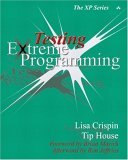 This book explains, in detail, the value of having a tester role on an XP project. Much of what is written on XP focuses on the role of developers in writing tests, and this book will help you understand the value that testing professionals can add to an XP, or other agile, project. The function of a tester changes when a team applies XP; In the spirt of lean software development, this book shows you how to apply the skills of testers in a new environment. One minor flaw in the book is that it is targeted at testers. While testers need to understand how to apply their skills to an XP environment, others such as Coaches, programmers and project managers also need to understand the value of testers. Get this book to understand how testers can improve your XP project.
This book explains, in detail, the value of having a tester role on an XP project. Much of what is written on XP focuses on the role of developers in writing tests, and this book will help you understand the value that testing professionals can add to an XP, or other agile, project. The function of a tester changes when a team applies XP; In the spirt of lean software development, this book shows you how to apply the skills of testers in a new environment. One minor flaw in the book is that it is targeted at testers. While testers need to understand how to apply their skills to an XP environment, others such as Coaches, programmers and project managers also need to understand the value of testers. Get this book to understand how testers can improve your XP project.Related books
 This is an excellent book about how to develop software quickly in the face of changing requirements, and the definitive description of what Extreme Programming is. The second edition reflects the experience of doing XP for the 5 years since the first edition came out. This edition clearly explains the relationships between principles, practices and values, which is a frequent topic of discussion in the XP community. Extreme Programming Explained, 2nd Edition is really about the human side of programming; With this book Kent Beck has earned a seat next to Jerry Weinberg as someone who understands how to apply an understanding of human nature to the problem of how to build software effectively. Get this book if you want to apply XP in your organization, or even if you simply want to improve your practices; there is much to learn from the XP approach, even if you can not, or will not, apply it fully.
This is an excellent book about how to develop software quickly in the face of changing requirements, and the definitive description of what Extreme Programming is. The second edition reflects the experience of doing XP for the 5 years since the first edition came out. This edition clearly explains the relationships between principles, practices and values, which is a frequent topic of discussion in the XP community. Extreme Programming Explained, 2nd Edition is really about the human side of programming; With this book Kent Beck has earned a seat next to Jerry Weinberg as someone who understands how to apply an understanding of human nature to the problem of how to build software effectively. Get this book if you want to apply XP in your organization, or even if you simply want to improve your practices; there is much to learn from the XP approach, even if you can not, or will not, apply it fully.Related books
- Software Configuration Management Patterns: Effective Teamwork, Practical Integration
- The Pragmatic Programmer: From Journeyman to Master
- Test Driven Development: By Example
- The Psychology of Computer Programming, Silver Anniversary Edition
- Agile Estimating and Planning
- User Stories Applied : For Agile Software Development (Addison-Wesley Signature Series)
 The material in this book is excellent, having been developed over a number of years. In addition to wonderful, well written, patterns that advise you on how to spread ideas, this books is full of stories that help you to understand how to use the patterns effectively to influence people, overcome roadblocks, and spread new ideas. Anyone who has new ideas to share will benefit from this book including: Managers and Team members, Professionals and Volunteers, people in industry and those in community organizations.
The material in this book is excellent, having been developed over a number of years. In addition to wonderful, well written, patterns that advise you on how to spread ideas, this books is full of stories that help you to understand how to use the patterns effectively to influence people, overcome roadblocks, and spread new ideas. Anyone who has new ideas to share will benefit from this book including: Managers and Team members, Professionals and Volunteers, people in industry and those in community organizations.Related books
 If you work with or live with other people you should read this book. It is filled with information on understanding how communication gaps happen, and practical advice for resolving commuunications issues with other people. Most of the advice seems obvious, yet it if often the obvious that one needs to be reminded of. Among the extremely practical bits of information in the book is are dicussions of communication models (so that you can understand why communication might break down), and a chapter on how to write Service Level Agreements.
If you work with or live with other people you should read this book. It is filled with information on understanding how communication gaps happen, and practical advice for resolving commuunications issues with other people. Most of the advice seems obvious, yet it if often the obvious that one needs to be reminded of. Among the extremely practical bits of information in the book is are dicussions of communication models (so that you can understand why communication might break down), and a chapter on how to write Service Level Agreements.Related books
 This book explains why lean manufacturing works. There is much you can learn about lean software development by learning about lean thinking in this, more concrete, domain. Read this book to learn the more general concepts of lean production so that you can better understand them and better explain them to your software development colleagues and management.
This book explains why lean manufacturing works. There is much you can learn about lean software development by learning about lean thinking in this, more concrete, domain. Read this book to learn the more general concepts of lean production so that you can better understand them and better explain them to your software development colleagues and management.Related books
 People build software systems in organizations, and the interesting problems often occur at the places where technology issues and people issues intersect. An understanding of how software organizations work is essential to building good software systems. Coplien and Harrison are two of the pioneers in writing patterns about software organizations, and this book is a useful guide to helping you understand how to build effective software development organizations.
People build software systems in organizations, and the interesting problems often occur at the places where technology issues and people issues intersect. An understanding of how software organizations work is essential to building good software systems. Coplien and Harrison are two of the pioneers in writing patterns about software organizations, and this book is a useful guide to helping you understand how to build effective software development organizations.Related books
 This book is about running requirements workshops and more. Requirements workshops are an important tool for understanding what you need to build. The techniques in this book will be useful in many other group discussion settings, and will help you have more productive meetings. The book discusses, among other things, roles in workshops and decision rules (deciding how to decide). Each chapter ends with a list of excellent references that you can use to probe further on techniques. Anyone who is involved in group decision making should own a copy of this book, read it, and refer back to it often.
This book is about running requirements workshops and more. Requirements workshops are an important tool for understanding what you need to build. The techniques in this book will be useful in many other group discussion settings, and will help you have more productive meetings. The book discusses, among other things, roles in workshops and decision rules (deciding how to decide). Each chapter ends with a list of excellent references that you can use to probe further on techniques. Anyone who is involved in group decision making should own a copy of this book, read it, and refer back to it often.Related books
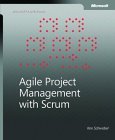 This book helped me understand more details about how to implement Scrum. The combines some simple overviews of Scrum rules and practices with case studies. The rules of Scrum are simple. Apply these rules in your context can be tricky. I found that the case studies that thread throughout the book really helped me to understand some of the nuances of the Scrum process. And if you want a checklist, there is a appendix that summarizes the rules of Scrum. This is a great book if you want to learn about Scrum as a project management tool, or if you have been trying to use Scrum and want a chance to renew your understanding.
This book helped me understand more details about how to implement Scrum. The combines some simple overviews of Scrum rules and practices with case studies. The rules of Scrum are simple. Apply these rules in your context can be tricky. I found that the case studies that thread throughout the book really helped me to understand some of the nuances of the Scrum process. And if you want a checklist, there is a appendix that summarizes the rules of Scrum. This is a great book if you want to learn about Scrum as a project management tool, or if you have been trying to use Scrum and want a chance to renew your understanding.Related books
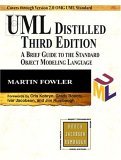 This is an excellent summary of the UML, and a great guide to how to express OO models using the UML. If you buy only one UML book, get this one. It The third edition is updated to the UML 2.0 spec. Fowler explains that the book is best for people who want to sketch UML diagrams to explain their designs, rather than who want to use UML for formally, but that may well be all you need to do with UML. This book also explains some key concepts of OO design. Every software developer should have a copy of this book on their shelves!
This is an excellent summary of the UML, and a great guide to how to express OO models using the UML. If you buy only one UML book, get this one. It The third edition is updated to the UML 2.0 spec. Fowler explains that the book is best for people who want to sketch UML diagrams to explain their designs, rather than who want to use UML for formally, but that may well be all you need to do with UML. This book also explains some key concepts of OO design. Every software developer should have a copy of this book on their shelves!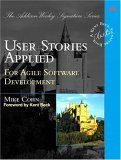 This is an excellent guide to writing User Stories. In addition to explaining what user stories are and how to write them, the book shows you how user stories fit into the development process and answers many of the common questions that arise when one starts writing stories. If you want to start using stories as part of your development process, buy this book; you'll want to read it and have it around for reference later.
This is an excellent guide to writing User Stories. In addition to explaining what user stories are and how to write them, the book shows you how user stories fit into the development process and answers many of the common questions that arise when one starts writing stories. If you want to start using stories as part of your development process, buy this book; you'll want to read it and have it around for reference later. This book answers many common questions about Pair Programming and supports the answers with data and stories. This is a very readable book, and will be an excellent resource for anyone trying to implement pair programming, or convince others of its usefulness in appropriate situations.
This book answers many common questions about Pair Programming and supports the answers with data and stories. This is a very readable book, and will be an excellent resource for anyone trying to implement pair programming, or convince others of its usefulness in appropriate situations. Project Retrospectives is a must have for anyone who wants(or needs)to understand what happened on their last project. If you plan to conduct a retrospective, the book will show you how with exercises to use with your group. Even if you do not run formal retrospectives, the techniques in this book will help you get a more candid view of how things on your project work.
Project Retrospectives is a must have for anyone who wants(or needs)to understand what happened on their last project. If you plan to conduct a retrospective, the book will show you how with exercises to use with your group. Even if you do not run formal retrospectives, the techniques in this book will help you get a more candid view of how things on your project work.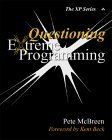 In this book McBreen gives a well reasoned discussion of what XP is and is not, when it works and when it might not work. The book is positive about the merits of XP, when used in the right setting. This book will be valuable to anyone who is considering changing their development approach, even is they are not considering Extreme Programming. Both enthusiast and skeptics alike will find the material in the book thought provoking.
In this book McBreen gives a well reasoned discussion of what XP is and is not, when it works and when it might not work. The book is positive about the merits of XP, when used in the right setting. This book will be valuable to anyone who is considering changing their development approach, even is they are not considering Extreme Programming. Both enthusiast and skeptics alike will find the material in the book thought provoking.Related books
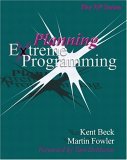 Planning Extreme Programming gives you advice on how to fit the XP Planning game, and related aspects into the larger context. This book will be particularly useful if you have had to reconcile the XP approach of incremental development and planning with an organization that takes a master plan approach.
Planning Extreme Programming gives you advice on how to fit the XP Planning game, and related aspects into the larger context. This book will be particularly useful if you have had to reconcile the XP approach of incremental development and planning with an organization that takes a master plan approach.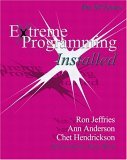 Extreme Programming Installed describes how to implement XP practices with practical advice based on experience. Buy this book when you are ready to implement XP for your team.
Extreme Programming Installed describes how to implement XP practices with practical advice based on experience. Buy this book when you are ready to implement XP for your team.Related books
 The principles that this book discusses: Release, Collaboration Ensemble and Play are extremely relevant to creating effective software teams. The principles are inspired by observing how theatre companies work, but they also have a basis in lean manufacturing. If you work as a software developer or manager and have ever worked on a theatre production (community theatre or at school) a light will go on immediately. If you haven't The data that the authors provide about lean manufacturing practices and software development will convince you that there is a lot that we can learn from this metaphor. The theatre examples will be helpful in explaining how the principles work if you need to communicate them to a manager who does not understand software development. Buy this book and place it along side your books on agile software development; you will want to read it and refer back to it frequently.
The principles that this book discusses: Release, Collaboration Ensemble and Play are extremely relevant to creating effective software teams. The principles are inspired by observing how theatre companies work, but they also have a basis in lean manufacturing. If you work as a software developer or manager and have ever worked on a theatre production (community theatre or at school) a light will go on immediately. If you haven't The data that the authors provide about lean manufacturing practices and software development will convince you that there is a lot that we can learn from this metaphor. The theatre examples will be helpful in explaining how the principles work if you need to communicate them to a manager who does not understand software development. Buy this book and place it along side your books on agile software development; you will want to read it and refer back to it frequently.Related books
 This book discusses the psychology of optimal experience, in other words, happiness. This books is not a how-to book, but rather a why book. Reading this book may give you great insights into how to enjoy all aspects of your work and private life.
This book discusses the psychology of optimal experience, in other words, happiness. This books is not a how-to book, but rather a why book. Reading this book may give you great insights into how to enjoy all aspects of your work and private life.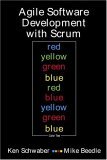 Excellent book that explains Scrum, one of the more popular agile development techniques. The approach in this book is very pragmatic. The authors discuss what Scrum is and how to apply it in various environments.
Excellent book that explains Scrum, one of the more popular agile development techniques. The approach in this book is very pragmatic. The authors discuss what Scrum is and how to apply it in various environments.Related books
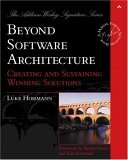 All you ever wanted to know about product management, but were afraid to ask. This book discusses the relationship between technical-architecture and marketing-architecture. This is an oft-neglected subject, but it is important as marketing and technology are both important for a successful product. This is a great book to read if you design software systems, or are involved in product management.
All you ever wanted to know about product management, but were afraid to ask. This book discusses the relationship between technical-architecture and marketing-architecture. This is an oft-neglected subject, but it is important as marketing and technology are both important for a successful product. This is a great book to read if you design software systems, or are involved in product management. You should buy this book if you have any role in making decisions about your project. It discusses how how manage risks and explains why some corporate cultures discourage risk management, often to their disadvantage. The writing is very clear. This is a quick and informative read.
You should buy this book if you have any role in making decisions about your project. It discusses how how manage risks and explains why some corporate cultures discourage risk management, often to their disadvantage. The writing is very clear. This is a quick and informative read.Related books
 This is a classic book. Everyone involved with software systems: developers, managers, and customers, should read this book.
This is a classic book. Everyone involved with software systems: developers, managers, and customers, should read this book.Related books
 This is a unique book. It tells you about the writers workshop process. The writers workshop process has its origins in the creative writing community, and has been used in the software patterns community. Richard Gabriel explains how the process can also be used in other domains where creative effort is involved, such as reviewing marketing materials. I book for two reasons. First it provide great insight into the creative process (as applied to anything) and the values that are used in the writers workshop can benefit anyone who creates things, even if they don't use the workshop process. Second, if you do want to use writers workshops, this book explains the hows and whys of them. I had been involved in workshopping software patterns since 1995, and I though that I pretty much understood what they were about. I learned a lot reading this book. I recommend this book for anyone who involved in the creative process(of any sort): Software engineers, writers, teachers, and students.
This is a unique book. It tells you about the writers workshop process. The writers workshop process has its origins in the creative writing community, and has been used in the software patterns community. Richard Gabriel explains how the process can also be used in other domains where creative effort is involved, such as reviewing marketing materials. I book for two reasons. First it provide great insight into the creative process (as applied to anything) and the values that are used in the writers workshop can benefit anyone who creates things, even if they don't use the workshop process. Second, if you do want to use writers workshops, this book explains the hows and whys of them. I had been involved in workshopping software patterns since 1995, and I though that I pretty much understood what they were about. I learned a lot reading this book. I recommend this book for anyone who involved in the creative process(of any sort): Software engineers, writers, teachers, and students. This book describes Essential SCM practices. Developers, team leaders and those just learning about software configuration management should find this book useful.
This book describes Essential SCM practices. Developers, team leaders and those just learning about software configuration management should find this book useful.Related books
 This is an excellent book that explains very clearly how working longer hours with fewer resources in the quest for efficiency is counter productive for knowledge work, such as software development. This is a quick read, with many interesting stories to support the assertions that the book makes. The book is targeted at managers but also makes the point that leadership can happen at any level in the organization.
This is an excellent book that explains very clearly how working longer hours with fewer resources in the quest for efficiency is counter productive for knowledge work, such as software development. This is a quick read, with many interesting stories to support the assertions that the book makes. The book is targeted at managers but also makes the point that leadership can happen at any level in the organization. An excellent survey to the principles of agile development approaches such as Extreme Programming , SCRUM, and others. The book mixes discussions of the core ideas with interviews with some of the founders of the Agile Alliance .
An excellent survey to the principles of agile development approaches such as Extreme Programming , SCRUM, and others. The book mixes discussions of the core ideas with interviews with some of the founders of the Agile Alliance .Related books
 DeMarco's book is similar in style to The Goal but covers software development rather than manufacturing. The protagonist takes on a difficult management assignment and learns many of th e lessons of modern project management. It is a quick, enjoyable read, and it passes on its lessons with humor, so they are easily remembered. You will want to read some more traditional books on project management, it addition to this book, but this book motivates the lessons in more traditional books.
DeMarco's book is similar in style to The Goal but covers software development rather than manufacturing. The protagonist takes on a difficult management assignment and learns many of th e lessons of modern project management. It is a quick, enjoyable read, and it passes on its lessons with humor, so they are easily remembered. You will want to read some more traditional books on project management, it addition to this book, but this book motivates the lessons in more traditional books. A classic book! This is the original text with comments by Weinberg at the end of each chapter on what he'd say differently now. It is easy to get past the examples which revolve around batch systems, and realize that the core ideas in the book are still valid.
A classic book! This is the original text with comments by Weinberg at the end of each chapter on what he'd say differently now. It is easy to get past the examples which revolve around batch systems, and realize that the core ideas in the book are still valid.Related books
 This book has lots of good information for technical people at all levels. This book even has some good work-style and problem solving ideas for non-technical people.
This book has lots of good information for technical people at all levels. This book even has some good work-style and problem solving ideas for non-technical people.Related books
 Everyone consults, according to Weinberg, and you'll find lots of useful stuff here, whether you are a full time employee, contract employee, or someone who is considering consulting.
Everyone consults, according to Weinberg, and you'll find lots of useful stuff here, whether you are a full time employee, contract employee, or someone who is considering consulting.Related books
 This book talks about how you can keep yourself focused on doing the right things. The text and examples are geared to consultants, but most everyone will find these "tools" useful.
This book talks about how you can keep yourself focused on doing the right things. The text and examples are geared to consultants, but most everyone will find these "tools" useful.Related books
 The three books of the 4 volume Quality Software Management series I've read (Volume 1: Systems Thinking , Volume 2: First-Order Measurement , and Volume 3: Congruent Action ) had really good stuff on the people issues that affect software development. Even if you are not a manager, these books provide you with information on how to work more effectively with team members and managers alike, and, understand, if not justify some annoying management practices. (I haven't yet read Volume 4: Anticipating Change , but there is probably valuable stuff in there as well.)
The three books of the 4 volume Quality Software Management series I've read (Volume 1: Systems Thinking , Volume 2: First-Order Measurement , and Volume 3: Congruent Action ) had really good stuff on the people issues that affect software development. Even if you are not a manager, these books provide you with information on how to work more effectively with team members and managers alike, and, understand, if not justify some annoying management practices. (I haven't yet read Volume 4: Anticipating Change , but there is probably valuable stuff in there as well.) Even if you are not a manager, the books in this Quality Software Management Series provide you with information on how to work more effectively with team members and managers alike, and, understand, if not justify some annoying management practices.
Even if you are not a manager, the books in this Quality Software Management Series provide you with information on how to work more effectively with team members and managers alike, and, understand, if not justify some annoying management practices. Even if you are not a manager, the books in this Quality Software Management Series provide you with information on how to work more effectively with team members and managers alike, and, understand, if not justify some annoying management practices.
Even if you are not a manager, the books in this Quality Software Management Series provide you with information on how to work more effectively with team members and managers alike, and, understand, if not justify some annoying management practices. This book is about how people make decisions in a variety of circumstances. This includes solo decision making in crisis situations, as well as team decisions. Discusses the value of stories in expressing and clarifying the decision making process. The discussion of stories (known uses) and the importance of clarifying intent while giving instructions make this worthwhile reading for those studying patterns as a means of conveying expertise.
This book is about how people make decisions in a variety of circumstances. This includes solo decision making in crisis situations, as well as team decisions. Discusses the value of stories in expressing and clarifying the decision making process. The discussion of stories (known uses) and the importance of clarifying intent while giving instructions make this worthwhile reading for those studying patterns as a means of conveying expertise. This book really made me think about my work, both day to day and career-wise. Covers practical approaches to improving culture, communication, and work environment. My favorite chapters were Avoiding Bad Working Environments and Working In a Poor Environment .
This book really made me think about my work, both day to day and career-wise. Covers practical approaches to improving culture, communication, and work environment. My favorite chapters were Avoiding Bad Working Environments and Working In a Poor Environment . An excellent resource on how to approach issues at work and at home. Should be required reading for everyone who is part of a team or a relationship.
An excellent resource on how to approach issues at work and at home. Should be required reading for everyone who is part of a team or a relationship.Related books
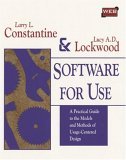 This is an excellent book about how to build good interfaces. The book, at first glance, is geared towards uasbility professionals, but anyone who has a role in building or specifying systems that have some sort of user interface will benefit from reading, and referring to, this book.
This is an excellent book about how to build good interfaces. The book, at first glance, is geared towards uasbility professionals, but anyone who has a role in building or specifying systems that have some sort of user interface will benefit from reading, and referring to, this book.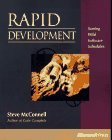 An excellent book that describes best practices for the entire software development lifecycle. This should be required reading for anyone planning or working on a software project.
An excellent book that describes best practices for the entire software development lifecycle. This should be required reading for anyone planning or working on a software project.Related books